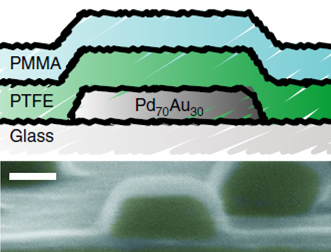World's fastest hydrogen sensor could pave the way for clean energy
Hydrogen is a clean and sustainable energy carrier that can power vehicles with only water as the emission. The problem is that hydrogen gas is highly flammable when mixed with air, so efficient sensors are required. Now, a consortium of researchers lead by Prof Langhammer at Chalmers University of Technology in collaboration with the group of Bernard Dam (TU Delft/e-Refinery) present the first hydrogen sensor in the world to meet the strict future performance targets for application in hydrogen-powered vehicles.
The researchers’ ground-breaking results were recently published in the prestigious scientific journal Nature Materials. The discovery is an optical nanosensor encapsulated in a plastic material. The sensor works based on an optical phenomenon – a plasmon – which occurs when metal nanoparticles are illuminated and capture visible light. The sensor simply changes colour when the amount of hydrogen in the environment changes.
The plastic around the tiny sensor is not just for protection, but functions as a key component. It increases the sensor’s response time by accelerating the uptake of the hydrogen gas molecules into the metal particles where they can be detected. At the same time, the plastic acts as an effective barrier to the environment, preventing any other molecules from entering and deactivating the sensor. The sensor can therefore work both highly efficiently and undisturbed, enabling it to meet the rigorous demands of the automotive industry – to be capable of detecting 0.1 percent hydrogen in the air in less than a second.
Detecting hydrogen is challenging in many ways. The gas is invisible, odourless, volatile and extremely flammable. It requires only four percent hydrogen in the air to produce oxyhydrogen gas, sometimes known as “knallgas”, which ignites at the smallest spark. In order for the hydrogen cars and the associated infrastructure of the future to be sufficiently safe, it must therefore be possible to detect extremely small amounts of hydrogen in the air. The sensors need to be quick enough that leaks can be rapidly detected before a fire occurs.
Although the aim is primarily to use hydrogen as an energy carrier, the sensor also presents other possibilities. Highly efficient hydrogen sensors are needed in the electricity network industry, the chemical and nuclear power industry, and can also help improve medical diagnostics. The amount of hydrogen gas in our breath can provide answers to, for example, inflammations and food intolerances.
Read “Metal–polymer hybrid nanomaterials for plasmonic ultrafast hydrogen detection” in Nature Materials 2019
